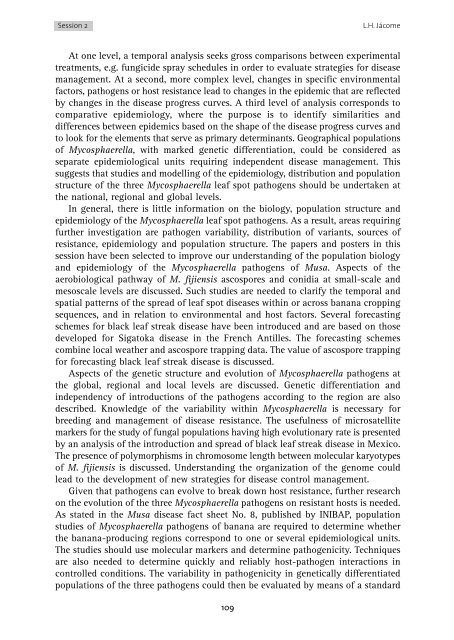Mycosphaerella leaf spot diseases of bananas - CBS
Mycosphaerella leaf spot diseases of bananas - CBS
Mycosphaerella leaf spot diseases of bananas - CBS
Create successful ePaper yourself
Turn your PDF publications into a flip-book with our unique Google optimized e-Paper software.
Session 2<br />
L.H. Jácome<br />
At one level, a temporal analysis seeks gross comparisons between experimental<br />
treatments, e.g. fungicide spray schedules in order to evaluate strategies for disease<br />
management. At a second, more complex level, changes in specific environmental<br />
factors, pathogens or host resistance lead to changes in the epidemic that are reflected<br />
by changes in the disease progress curves. A third level <strong>of</strong> analysis corresponds to<br />
comparative epidemiology, where the purpose is to identify similarities and<br />
differences between epidemics based on the shape <strong>of</strong> the disease progress curves and<br />
to look for the elements that serve as primary determinants. Geographical populations<br />
<strong>of</strong> <strong>Mycosphaerella</strong>, with marked genetic differentiation, could be considered as<br />
separate epidemiological units requiring independent disease management. This<br />
suggests that studies and modelling <strong>of</strong> the epidemiology, distribution and population<br />
structure <strong>of</strong> the three <strong>Mycosphaerella</strong> <strong>leaf</strong> <strong>spot</strong> pathogens should be undertaken at<br />
the national, regional and global levels.<br />
In general, there is little information on the biology, population structure and<br />
epidemiology <strong>of</strong> the <strong>Mycosphaerella</strong> <strong>leaf</strong> <strong>spot</strong> pathogens. As a result, areas requiring<br />
further investigation are pathogen variability, distribution <strong>of</strong> variants, sources <strong>of</strong><br />
resistance, epidemiology and population structure. The papers and posters in this<br />
session have been selected to improve our understanding <strong>of</strong> the population biology<br />
and epidemiology <strong>of</strong> the <strong>Mycosphaerella</strong> pathogens <strong>of</strong> Musa. Aspects <strong>of</strong> the<br />
aerobiological pathway <strong>of</strong> M. fijiensis ascospores and conidia at small-scale and<br />
mesoscale levels are discussed. Such studies are needed to clarify the temporal and<br />
spatial patterns <strong>of</strong> the spread <strong>of</strong> <strong>leaf</strong> <strong>spot</strong> <strong>diseases</strong> within or across banana cropping<br />
sequences, and in relation to environmental and host factors. Several forecasting<br />
schemes for black <strong>leaf</strong> streak disease have been introduced and are based on those<br />
developed for Sigatoka disease in the French Antilles. The forecasting schemes<br />
combine local weather and ascospore trapping data. The value <strong>of</strong> ascospore trapping<br />
for forecasting black <strong>leaf</strong> streak disease is discussed.<br />
Aspects <strong>of</strong> the genetic structure and evolution <strong>of</strong> <strong>Mycosphaerella</strong> pathogens at<br />
the global, regional and local levels are discussed. Genetic differentiation and<br />
independency <strong>of</strong> introductions <strong>of</strong> the pathogens according to the region are also<br />
described. Knowledge <strong>of</strong> the variability within <strong>Mycosphaerella</strong> is necessary for<br />
breeding and management <strong>of</strong> disease resistance. The usefulness <strong>of</strong> microsatellite<br />
markers for the study <strong>of</strong> fungal populations having high evolutionary rate is presented<br />
by an analysis <strong>of</strong> the introduction and spread <strong>of</strong> black <strong>leaf</strong> streak disease in Mexico.<br />
The presence <strong>of</strong> polymorphisms in chromosome length between molecular karyotypes<br />
<strong>of</strong> M. fijiensis is discussed. Understanding the organization <strong>of</strong> the genome could<br />
lead to the development <strong>of</strong> new strategies for disease control management.<br />
Given that pathogens can evolve to break down host resistance, further research<br />
on the evolution <strong>of</strong> the three <strong>Mycosphaerella</strong> pathogens on resistant hosts is needed.<br />
As stated in the Musa disease fact sheet No. 8, published by INIBAP, population<br />
studies <strong>of</strong> <strong>Mycosphaerella</strong> pathogens <strong>of</strong> banana are required to determine whether<br />
the banana-producing regions correspond to one or several epidemiological units.<br />
The studies should use molecular markers and determine pathogenicity. Techniques<br />
are also needed to determine quickly and reliably host-pathogen interactions in<br />
controlled conditions. The variability in pathogenicity in genetically differentiated<br />
populations <strong>of</strong> the three pathogens could then be evaluated by means <strong>of</strong> a standard<br />
109

















